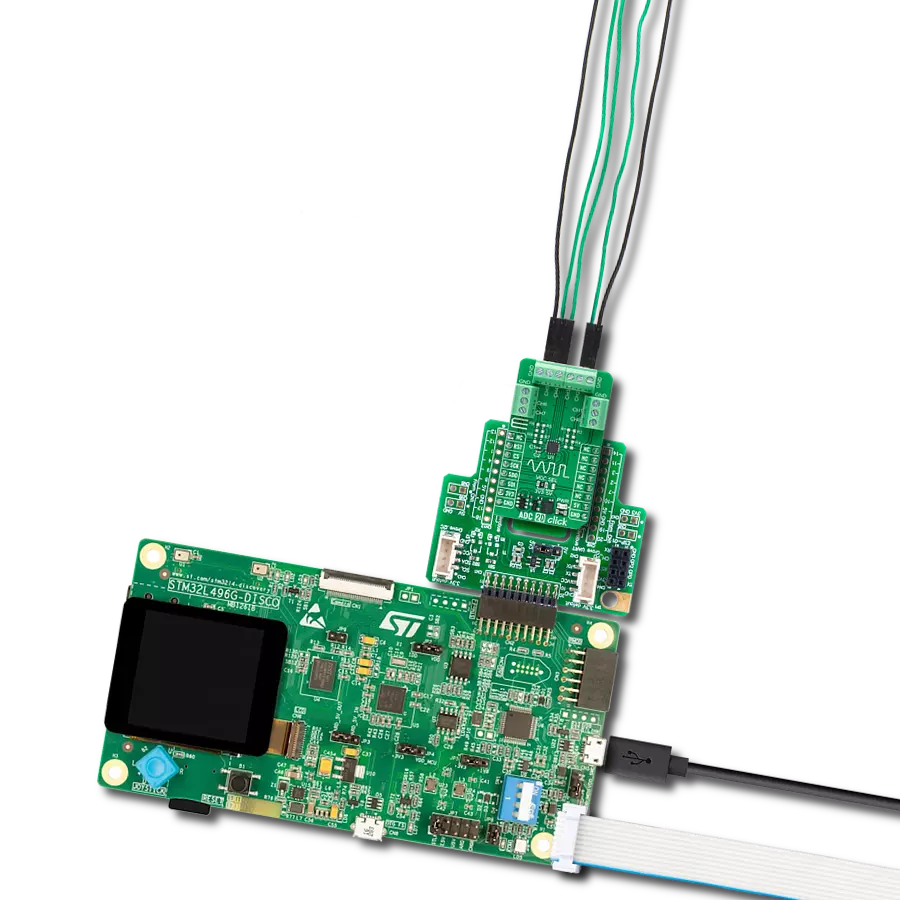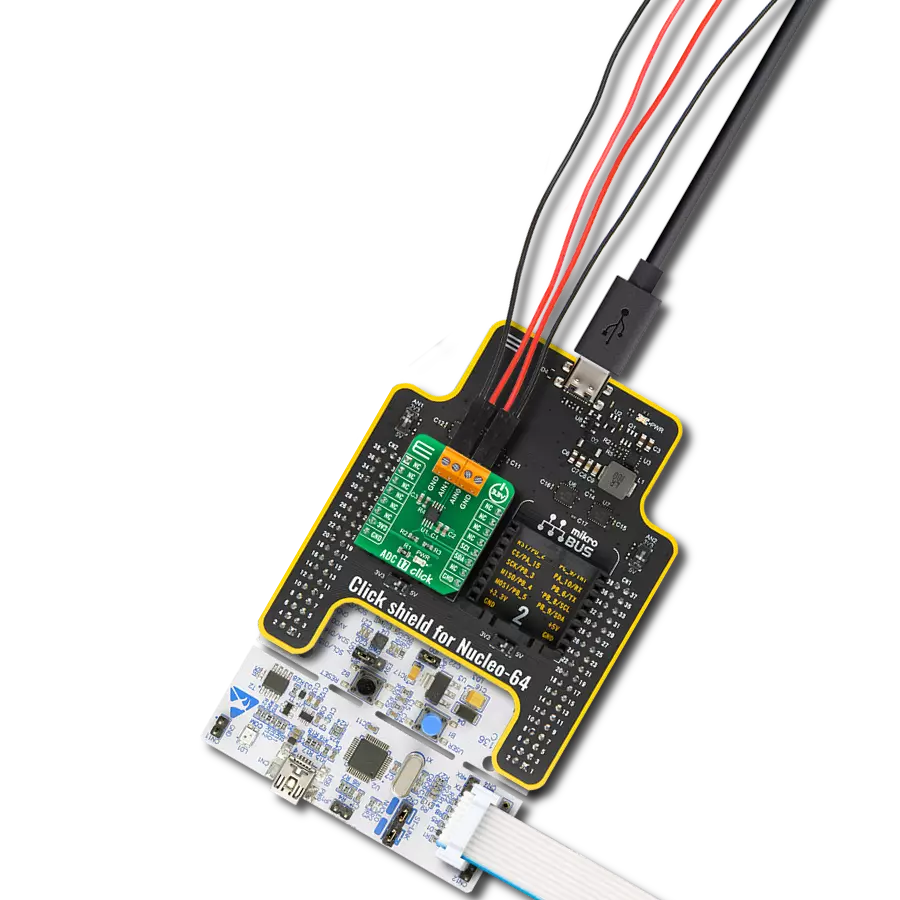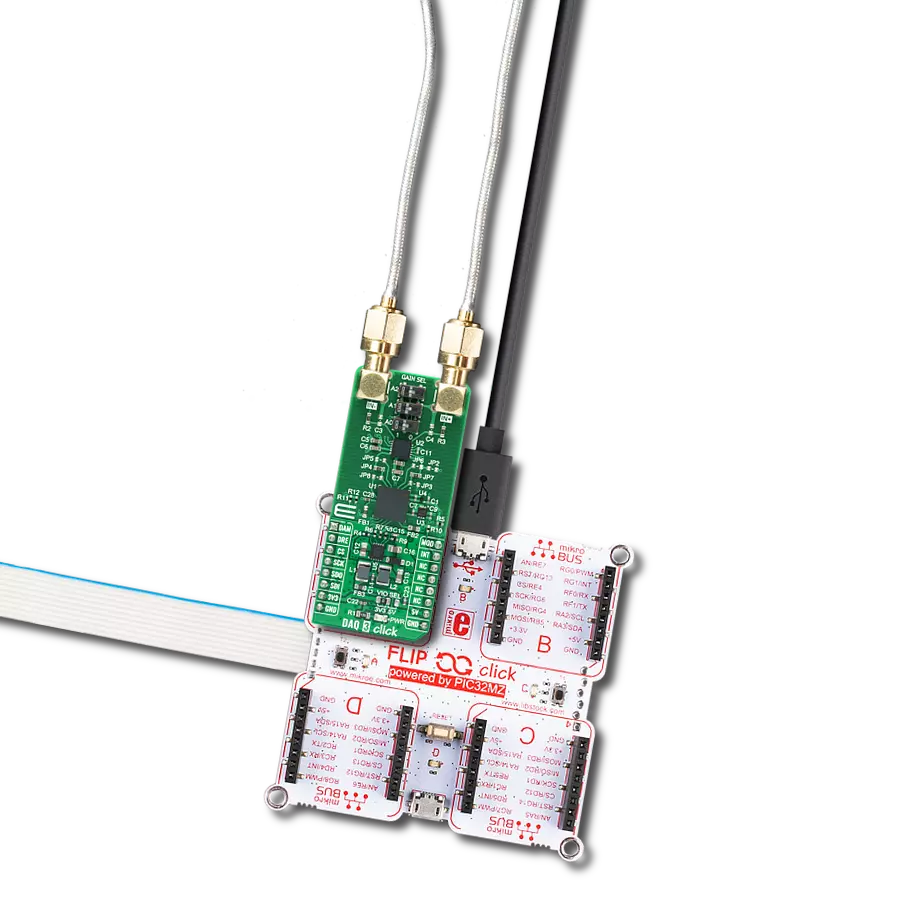Ready to take on even the most demanding designs? Our high-performance ADC is up to the challenge!
A
A
Hardware Overview
How does it work?
ADC 21 Click is based on the ADC1283, a high-performance eight-channel analog-to-digital converter from STMicroelectronics. The ADC1283 implements a successive approximation register (SAR) structure to convert analog signals into 12-bit pure binary digital outputs. The conversion circuit includes a fast settling time comparator to convey instruction into the register to store digital 0 or 1 and a redistribution DAC with logic control to have the ADC compare the track signal with a reference signal at each clock cycle. ADC 21 Click communicates with MCU through a standard SPI interface and operates at clock rates up to 3.2MHz,
for all configurations and acquiring conversion results. The AD conversion is carried out in two phases. The sampling phase conveys the input signal through the capacitance array for the first three clock cycles, and then, the evaluation phase performs the conversion into a digital 12-bit signal within 13 clock cycles. At each clock cycle of the evaluation phase, the hold signal is compared with a new value distributed by the DAC, and the result is stored in the 12-bit register, with MSB first. A complete conversion requires 16 clock cycles to generate a new 12-bit word on the SDO pin on the mikroBUS™ socket. This Click board™ can operate with
either 3.3V or 5V logic voltage levels selected via the VCC SEL jumper. This way, it is allowed for both 3.3V and 5V capable MCUs to use the communication lines properly. Additionally, there is a possibility for the ADC1283 analog power supply selection via jumper labeled AVCC SEL to supply the ADC1283 from an external power supply, in the range from 2.7V to 5.5V or with mikroBUS™ power rails. However, the Click board™ comes equipped with a library containing easy-to-use functions and an example code that can be used, as a reference, for further development.
Features overview
Development board
Arduino UNO is a versatile microcontroller board built around the ATmega328P chip. It offers extensive connectivity options for various projects, featuring 14 digital input/output pins, six of which are PWM-capable, along with six analog inputs. Its core components include a 16MHz ceramic resonator, a USB connection, a power jack, an
ICSP header, and a reset button, providing everything necessary to power and program the board. The Uno is ready to go, whether connected to a computer via USB or powered by an AC-to-DC adapter or battery. As the first USB Arduino board, it serves as the benchmark for the Arduino platform, with "Uno" symbolizing its status as the
first in a series. This name choice, meaning "one" in Italian, commemorates the launch of Arduino Software (IDE) 1.0. Initially introduced alongside version 1.0 of the Arduino Software (IDE), the Uno has since become the foundational model for subsequent Arduino releases, embodying the platform's evolution.
Microcontroller Overview
MCU Card / MCU

Architecture
AVR
MCU Memory (KB)
32
Silicon Vendor
Microchip
Pin count
28
RAM (Bytes)
2048
You complete me!
Accessories
Click Shield for Arduino UNO has two proprietary mikroBUS™ sockets, allowing all the Click board™ devices to be interfaced with the Arduino UNO board without effort. The Arduino Uno, a microcontroller board based on the ATmega328P, provides an affordable and flexible way for users to try out new concepts and build prototypes with the ATmega328P microcontroller from various combinations of performance, power consumption, and features. The Arduino Uno has 14 digital input/output pins (of which six can be used as PWM outputs), six analog inputs, a 16 MHz ceramic resonator (CSTCE16M0V53-R0), a USB connection, a power jack, an ICSP header, and reset button. Most of the ATmega328P microcontroller pins are brought to the IO pins on the left and right edge of the board, which are then connected to two existing mikroBUS™ sockets. This Click Shield also has several switches that perform functions such as selecting the logic levels of analog signals on mikroBUS™ sockets and selecting logic voltage levels of the mikroBUS™ sockets themselves. Besides, the user is offered the possibility of using any Click board™ with the help of existing bidirectional level-shifting voltage translators, regardless of whether the Click board™ operates at a 3.3V or 5V logic voltage level. Once you connect the Arduino UNO board with our Click Shield for Arduino UNO, you can access hundreds of Click boards™, working with 3.3V or 5V logic voltage levels.
Used MCU Pins
mikroBUS™ mapper
Take a closer look
Click board™ Schematic

Step by step
Project assembly
Software Support
Library Description
This library contains API for ADC 21 Click driver.
Key functions:
adc21_read_raw_adcThis function reads raw ADC value from the selected channel by using SPI serial interface.adc21_read_voltageThis function reads raw ADC value from the selected channel and converts it to proportional voltage level depending on the AVCC selection.
Open Source
Code example
The complete application code and a ready-to-use project are available through the NECTO Studio Package Manager for direct installation in the NECTO Studio. The application code can also be found on the MIKROE GitHub account.
/*!
* @file main.c
* @brief ADC 21 Click example
*
* # Description
* This example demonstrates the use of ADC 21 Click board by reading and displaying
* the voltage levels from 8 analog input channels.
*
* The demo application is composed of two sections :
*
* ## Application Init
* Initializes the driver and logger.
*
* ## Application Task
* Reads the voltage levels from all 8 analog input channels and displays the results
* on the USB UART once per second approximately.
*
* @author Stefan Filipovic
*
*/
#include "board.h"
#include "log.h"
#include "adc21.h"
static adc21_t adc21;
static log_t logger;
void application_init ( void )
{
log_cfg_t log_cfg; /**< Logger config object. */
adc21_cfg_t adc21_cfg; /**< Click config object. */
/**
* Logger initialization.
* Default baud rate: 115200
* Default log level: LOG_LEVEL_DEBUG
* @note If USB_UART_RX and USB_UART_TX
* are defined as HAL_PIN_NC, you will
* need to define them manually for log to work.
* See @b LOG_MAP_USB_UART macro definition for detailed explanation.
*/
LOG_MAP_USB_UART( log_cfg );
log_init( &logger, &log_cfg );
log_info( &logger, " Application Init " );
// Click initialization.
adc21_cfg_setup( &adc21_cfg );
ADC21_MAP_MIKROBUS( adc21_cfg, MIKROBUS_1 );
if ( SPI_MASTER_ERROR == adc21_init( &adc21, &adc21_cfg ) )
{
log_error( &logger, " Communication init." );
for ( ; ; );
}
log_info( &logger, " Application Task " );
}
void application_task ( void )
{
static uint8_t ch_num = ADC21_CHANNEL_0;
float ch_voltage;
if ( ADC21_OK == adc21_read_voltage ( &adc21, ch_num, ADC21_AVCC_3V3, &ch_voltage ) )
{
log_printf ( &logger, " CH%u voltage: %.2f V\r\n", ( uint16_t ) ch_num, ch_voltage );
}
if ( ++ch_num > ADC21_CHANNEL_7 )
{
log_printf ( &logger, " ------------------------\r\n\n" );
ch_num = ADC21_CHANNEL_0;
Delay_ms ( 1000 );
}
}
int main ( void )
{
/* Do not remove this line or clock might not be set correctly. */
#ifdef PREINIT_SUPPORTED
preinit();
#endif
application_init( );
for ( ; ; )
{
application_task( );
}
return 0;
}
// ------------------------------------------------------------------------ END
Additional Support
Resources
Category:ADC



































